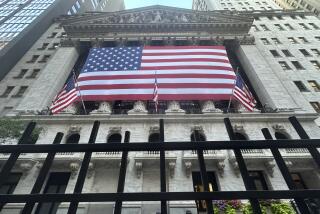Weak August May Bode Well for Fall
- Share via
Who’s afraid of September and October?
Investors starved for good news may find solace in a report Friday showing that the stock market’s seasonal trends bode well for the next several months--thanks, oddly enough, to last month’s sell-off.
After declining in August, as it did with a vengeance this year, the market historically has tended to stabilize in September and October and notch healthy gains in the last four months of the year, according to New York-based Instinet Research.
In the usually weak September-October span, the benchmark Standard & Poor’s 500 index has risen an average of 0.4% after negative Augusts since 1928, compared with a drop of 1.5% after positive Augusts. In recent years, the trend has been even sharper after lousy Augusts: an average two-month climb of 4.9%.
The post-August trends are similar for the September-December period, Instinet found. Over the last 72 years, after a weak August the S&P; 500 has risen an average of 2.4% for the remainder of the year, more than double the average climb of 1.1% following positive Augusts.
“It would be better if Sun Microsystems suddenly came out with better-than-expected earnings, but for investors looking for something to hang their hat on, this offers a glimmer of hope,” said Russ Koesterich, an analyst at Instinet, which is a unit of the British firm Reuters. “As much as you can find a silver lining these days, this is it.”
Much has been made of the market’s past troubles in September and October. Since 1928, September has been the market’s most dismal month, on average, with a loss of 0.9% in the S&P; 500. October has been the fourth-worst month, with an average gain of 0.3%, but it is famous for several punishing downturns, as happened in 1987 and, of course, in 1929.
But, according to Instinet, how August plays out tends to have a pivotal effect on the market’s fall direction, whether the relationship is cause-and-effect or coincidental.
This year, the S&P; sank 6.4% in August.
“We saw the mirror image of this last year,” Koesterich said, noting that August’s 6.1% advance preceded September’s 5.4% slide.
In a dramatic example of the trend that bulls are hoping for this year, the S&P; 500 tumbled 14.6% in August 1998 before surging in the fall.
“What this really speaks to is reversion to the mean,” Koesterich said. “Just when you think the market is going one way forever--that’s when you get a reversal.”
Reversals indeed have been the norm in recent years, especially after a weak August. In the last five Augusts in which the S&P; 500 has fallen--1992, 1995, 1997, 1998 and 1999--it has rebounded each time in the September-October period.
(BEGIN TEXT OF INFOBOX / INFOGRAPHIC)
The August Effect
The stock market tends to stabilize after a weak August--which should come as welcome news to shellshocked investors. Here’s how this historical trend has played out in recent years.
*--*
--S&P; 500 index % change--- Year August Sept.-Oct. 1999 --0.6% +3.2% 1998 --14.6 +14.8 1997 --5.7 +1.7 1995 --0.0 +3.5 1992 --2.4 +1.1 5-year avg. + 4.9
*--*
Avg. change after negative
Augusts since 1928: +0.4
Sources: Instinet, Times research
*
RELATED STORY
‘70s revisited: Things haven’t been this bad for mutual fund investors since the era of Watergate. C3
More to Read
Inside the business of entertainment
The Wide Shot brings you news, analysis and insights on everything from streaming wars to production — and what it all means for the future.
You may occasionally receive promotional content from the Los Angeles Times.










